上海知识产权法院知识产权司法保护状况(2018年)
上海知识产权法院
知识产权司法保护状况(2018年)
2018年,上海知识产权法院在上海市委的领导下,在市人大及其常委会的监督下,在上级法院的指导下,以习近平新时代中国特色社会主义思想为指导,全面贯彻党的十九大精神,深入推进知识产权审判工作机制创新,充分发挥司法保护知识产权的主导作用,不断提升司法公信力和影响力,为上海加快建设“五个中心”和社会主义现代化国际大都市提供了有力的司法服务和保障。
一、案件审理情况
2018年,共受理各类知识产权案件2067件,同比增长1.82%,收案数逐年上升。其中,民事一审案件1039件,民事二审案件951件,行政二审案件3件,诉前保全案件23件,其他案件51件。(图1)

图1 案件受理数量对比图
在受理的全部案件中,收案数位居前五位的案件分别是著作权案件605件(不包括计算机软件著作权),占29.27%;专利权案件587件,占28.40%;计算机软件案件396件,占19.16%;商标权案件237件,占11.47%;特许经营合同案件82件,占3.97%。另外,不正当竞争案件76件,技术合同案件19件,垄断案件7件,其他案件58件。(图2)
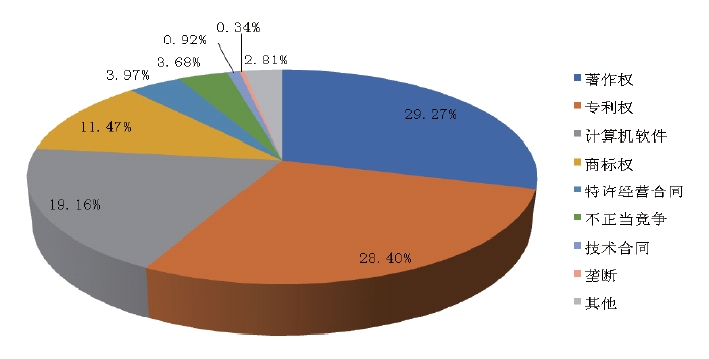
图2案由分布图
在受理的一审案件中,专利、计算机软件、技术秘密、技术合同等技术类案件共1005件,占一审收案数量的96.73%。其中,侵害专利权案件546件,专利权权属案件30件,专利合同案件11件,计算机软件开发合同案件318件,计算机软件权属、侵权案件78件,技术秘密案件22件。(图3)
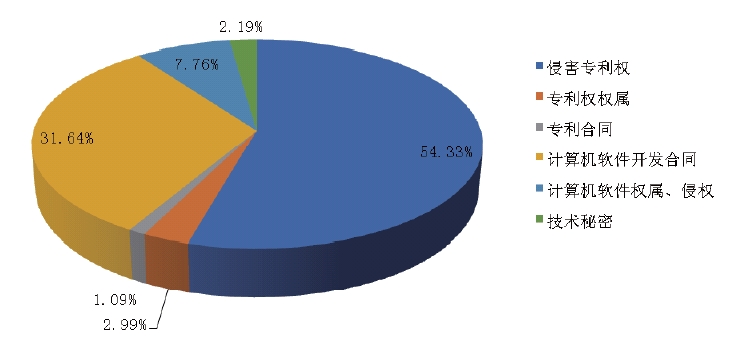
图3技术类案件分布图
审结各类案件2067件,同比增长1.77%。全年同期结案率为100%,实现案件收结良性循环。审结了一批新类型案件,例如,武汉市汉阳光明贸易有限责任公司与上海韩泰轮胎销售有限公司垄断纠纷案,系全国首例起诉被告同时实施纵向垄断协议和滥用市场支配地位的案件;北京搜狗信息服务有限公司与北京爱奇艺科技有限公司不正当竞争纠纷案,系一起涉及输入法中加载“搜索候选”功能是否构成不正当竞争的案件;麦迪韦逊医疗公司等与桂林南药股份有限公司等侵犯发明专利权纠纷案,涉及专利法中有关“实验例外”“仿制药例外”等专利侵权豁免规则适用的法律问题。还审结了一批涉知名中外企业、知名品牌,具有较大社会影响的案件。例如,沃尔沃·拉斯特韦格纳公司起诉的侵害外观设计专利权纠纷系列案、光明乳业股份有限公司与美食达人股份有限公司涉
二、全力服务保障国家战略实施和上海工作大局
紧紧围绕国家战略实施以及上海加快建设“五个中心”,特别是科创中心建设、自贸试验区建设、进口博览会等工作大局,着力提供良好的司法服务和有力的司法保障。
(一)服务保障上海科创中心建设
制定出台服务保障营商环境建设25条意见,着力营造有利于促进科技创新的法治化营商环境。依托最高人民法院在我院设立的知识产权司法保障科技创新研究(上海)基地,深入开展调研,编发《司法保障科技创新研究与参考》,及时向最高人民法院报送涉及科技创新知识产权保护的问题、做法,召开“科技创新与商业秘密司法保护”研讨会,有效发挥智库作用。充分发挥“全国审判业务专家陈惠珍法官工作室”的作用,每月深入科技园区开展调研和法制宣传,举办知识产权司法保护专题讲座,开展巡回审判,组织旁听庭审,发放知识产权典型案例册等,向企业宣传知识产权法律,促进创新创业企业尤其是中小微科创企业知识产权保护意识和能力的提升。
(二)服务保障自贸试验区建设
充分发挥自贸区知识产权案件集约化审理效应,确保自贸区知识产权案件专业高效审理,全年共受理案件310件,审结291件。参加涉自贸区知识产权司法保护专题论坛,联动上海市浦东新区人民法院自贸区知识产权法庭,加强适法疑难问题分析研究,统一裁判标准。深化与自贸区管委会的合作,召开企业座谈会,发布《涉自贸区知识产权案件审判情况(2015-2017)》,深度解读涉自贸区知识产权纠纷案件特点并提出加强保护的相关措施建议,向企业代表发放典型案例,听取意见建议,进一步提升涉自贸区知识产权保护的针对性和有效性。
(三)服务保障上海举办进口博览会
制定出台服务保障进口博览会15条意见,设立涉进博会案件专项审判团队,集中审理涉进博会知识产权案件。与相关基层法院建立涉进博会案件联络制度,强化案件指导和适法统一。建立专项数据分析平台,积极参与市高院、进口博览局召开的知识产权保护相关问题调研,对涉进博会案件态势及可能遇到的法律问题开展前瞻性调研和分析预判。在进博会召开前夕,梳理涉展会知识产权案件基本情况,分析在知识产权保护方面存在的普遍性问题并提出针对性建议,形成的《加强展会知识产权保护促进会展业健康发展》被评为2018年人民法院十大调研报告。
三、加大知识产权司法保护力度
(一)充分体现知识产权市场价值
对于能够查明权利人实际损失已超过法定最高赔偿额的,综合考虑涉案产品价值、侵权数量、持续时间等具体情节以及侵权行为人不提供侵权获利证据的实际情况,在法定最高赔偿限额以上酌情确定赔偿数额。在达索系统股份有限公司起诉的侵害计算机软件著作权纠纷案中,综合全案证据情况,根据上述赔偿数额认定规则,并考虑原被告提交的销售合同软件单价以及被告被行政处罚后仍扩大规模使用侵权软件等因素,判赔900万元,远远超出法定赔偿数额。充分发挥社会组织、中介机构在知识产权价值评估中的作用,确定符合知识产权市场价值的赔偿数额。在本田技研工业株式会社起诉的侵害发明专利权纠纷案中,根据会计师事务所对被控侵权产品销售情况的审计意见确定被告的侵权获利,判赔240万元。
(二)从严打击严重侵权行为
对于属于源头侵权、重复侵权、恶意侵权以及有其他严重侵权情节的,综合考虑行为危害性和主观恶意程度,依法从高确定赔偿数额,提高侵权行为人的违法成本,有效威慑和遏制侵犯知识产权的行为。对侵权产品制造商加大惩治力度,从生产源头上制止侵权行为。在马格内梯克控制系统(上海)有限公司提起上诉的侵害商业秘密纠纷案中,因被上诉人及被上诉人公司系侵权行为发生的源头,且具有利用公司的独立法律人格逃避法律责任的主观恶意,故我院对一审判令侵权人赔偿经济损失300万元予以维持。在
(三)依法支持权利人维权支出
对侵权事实及合理费用确定的案件,尽可能全面支持权利人的合理维权费用,降低权利人维权成本,保护权利人维权积极性。在佳能株式会社起诉的侵害发明专利权纠纷案中,鉴于原告为其主张的公证费、律师费等合理费用提供了相应的证据,结合律师的工作量及工作内容被法院采纳的程度,全额支持了原告为制止侵权行为所支出的合理费用14万元。在株式会社爱茉莉太平洋起诉的侵犯商标权纠纷案中,鉴于原告为证明涉案商标系驰名商标支出大量调查费、公证费及其他合理费用,并且提供了相应的证据,结合涉案商标属于驰名商标,全额支持了原告已经支出的合理费用5万元。
(四)加强权利实现的程序保障
充分发挥财产保全、证据保全、行为保全等司法临时措施的效能,对于当事人在诉前或者诉中提出的司法临时措施申请,积极受理、迅速审查、依法裁定、立即执行,为案件有效审理和纠纷化解打下坚实基础,2018年,共裁定支持当事人诉讼保全申请104件。在引导当事人积极举证的基础上,对于当事人确因客观原因无法自行收集证据,且符合调查令申请条件的,向其委托的律师签发法院调查令,2018年,共签发调查令36份,有效减轻权利人的举证负担。对于当事人具有无正当理由拒不提交或故意毁灭证据、提交虚假证据等妨碍诉讼行为的,依法采信申请人所主张的事实,并对妨碍人处以罚款、拘留等制裁措施。在东莞市宏邦精密机械科技有限公司起诉的侵害实用新型专利权纠纷案中,安置在被告处的被查封设备部分被拆解移动,被告单位负责人未尽到管理义务,导致司法查封的证据被毁损,故依法对被告单位负责人作出制裁。
四、构建知识产权保护新机制
(一)深化多元化纠纷解决机制
深化与调解组织和行业协会的合作,打造专业化调解平台和专业化、职业化、规范化调解员队伍。充分发挥诉前、诉中委托调解的制度效能,为当事人高效化解矛盾。2018年,经双方当事人同意进入诉前调解的案件86件,调解成功34件,诉前调解成功率达到39.5%;经双方当事人同意进入诉中委托调解的案件304件,调解成功123件,调解成功率达到40.46%。在一起发明专利侵权纠纷案件中,依靠诉前、诉中调解的灵活运用,原被告双方在法庭上握手言和,并在事后分别向我院发来感谢信。
(二)引入先行判决机制
针对知识产权案件审理耗时长的问题,引入先行判决机制。对于侵权性质可以判定,而其他事实尚需进一步审理的案件,先行判决停止侵权行为,提升司法救济的实效性。在瓦莱奥清洗系统公司起诉的侵害发明专利权纠纷案中,原告认为被告的侵权行为在案件审理过程中仍在持续,影响了原告的市场业务,请求法院先行判令被告停止侵权行为。合议庭经组织双方当事人对案件技术事实进行了充分的举证、质证、辩论,并由专家陪审员和技术调查官一同对涉案侵权产品进行勘验,最终认定被诉侵权产品落入原告享有的专利权保护范围,遂作出一审先行判决,判令被告立即停止对涉案发明专利权的侵害。
(三)完善多元化技术事实查明机制
针对知识产权案件技术性、专业性强的特点,持续深化技术调查、技术咨询、专家陪审和技术鉴定“四位一体”技术事实查明机制。根据案件实际情况,选择适用合适的技术事实查明方式。优先适用技术调查、技术咨询和专家陪审机制查明技术事实,并建立鉴定周期满45天提示、60天催告、结束后质量反馈制度,促进司法鉴定效率效果提升。在涉及多学科、多领域的知识产权案件中,积极探索技术调查官、技术咨询专家、专家陪审员和鉴定人协同联动机制。在北京搜狗科技发展有限公司起诉的侵害发明专利权纠纷案中,技术调查官、鉴定机构技术专家参加勘验,专家辅助人、鉴定人出庭质证,共同助力查明案件技术事实。2018年,技术调查官参与技术调查案件131件,较前年增长84.5%;完成技术咨询、保全、勘验、出庭412件次,较前年增长36.4%,取得良好的效果。
(四)拓展智能辅助办案机制
积极推进电子卷宗随案同步生成和深度应用,不断延伸拓展其功能,实现现代科技与审判工作的深度融合,促进审判能力现代化。探索诉讼材料全流程数字化采集,上下级法院间实现电子卷宗流转,在庭审举证、质证环节实现无纸化庭审示证,合议庭成员在线审阅电子卷宗材料、添加电子阅卷批注、进行网上评议、网上制作裁判文书等全流程网上办案;适用庭审智能语音转写系统,尝试在管辖权异议案件开庭中运用录音录像方式代替传统的书记员记录;参与市高院“206”工程和专利案件大数据分析数据库的建设等等。
五、营造知识产权保护的良好氛围
(一)持续加强知识产权保护宣传
突出宣传主题,充分展示知识产权司法保护的特色亮点内容。例如,在人民日报、新华社等中央媒体,就技术调查官制度运行作了深度报道;在解放日报上连续刊登关于破解知识产权保护“三大难题”的做法与成效;在新华社海外版、人民日报海外版、中国日报刊登《中国重视知识产权增强创新能力》等综合报道;在法制日报等法律专业媒体上重点介绍涉外案件审判情况;在中国知识产权报、知产力等知识产权相关媒体上,全面介绍我院知识产权司法保护状况。创新宣传形式,联合传统媒体和新媒体打造宣传矩阵。例如,在2018年世界知识产权日,上海人民广播电台早新闻整点播放知识产权保护公益报时;院庭长作为特邀嘉宾参加《法眼看天下·法院院长在线》特别节目直播访谈,与主持人、听众和网友等就知识产权保护进行互动交流;编发3本司法保障营商环境案例集和常见知识产权案例集,在官方网站上开设“以案释法”栏目,组织公众开放日10次,指派法官参与中国版权保护公益讲座等。
(二)持续提高知识产权审判影响力
强化知识产权司法调研,形成一批调研成果。在《法律适用》《人民司法》《上海审判实践》等期刊上发表各类论文、案例评析共46篇;《技术调查官在知识产权审判中的职能定位与体制协调》等5篇论文、案例评析在中国法学会审判理论研究会2018年年会征文评比、2018年全国法院系统年度优秀案例评比等活动中获奖;完成9个课题,其中《知识产权审判领域改革创新——以建立符合知识产权案件特点的诉讼证据规则为视角》获评2018年上海高院优秀重点调研课题。积极参与国际交流活动,发出知识产权司法保护的中国声音。先后有来自欧盟知识产权局、国际商标协会、日本、韩国、阿联酋阿布扎比酋长国等12批境外专家、同行来院交流;参加国际贸易规则与知识产权论坛、第十五届上海知识产权国际论坛暨全球知识产权保护和创新发展大会、新技术革命下的知识产权保护和竞争研讨会等活动;有4名法官赴国(境)外学习交流,多名法官受邀为“WIPO-同济大学知识产权硕士学位项目”授课。上海知识产权法院的公正高效审判获得了国内外组织、企业的高度赞赏。例如,北京嘀嘀无限科技发展有限公司感谢上海知识产权法院为保障企业合法权益、维护市场公平竞争秩序付出的不懈努力;SAP股份公司、欧瑞康纺织有限及两合公司、沃尔沃·拉斯特韦格纳公司等对上海知识产权法院平等尊重跨国公司知识产权、大力保护知识产权给予赞誉,称赞上海知识产权法院“建中国高效司法环境,树全球模范保护典型”。
(三)持续提升知识产权诉讼满意度
提升知识产权审判便利度。知识产权案件网上庭前会议、网上调解、网上庭审进入实质性运用,全年通过互联网远程视频方式开庭的案件共187件。在一起计算机软件开发合同纠纷案中,对无法到庭作证的证人采取通过视频连线对话方式,完成证人作证与当事人质证过程。深化诉讼服务中心、12368诉讼服务平台和网上律师服务平台建设,提升当事人和律师对诉讼服务的感受度、满意度,在为律师网上阅卷提供便利的基础上,重点推进网上立案,网上立案数共190件。委托公证送达机制有效运转,通过“公证云”数据储存平台,做到全程留痕,既提升了送达成功率,也对无法送达的情况进行公证保全,成功送达64件。提升知识产权审判透明度。加大庭审直播力度,平均每周2起案件在中国法院庭审直播网公开直播,依法公开全部应该公开的生效判决书,有效保障人民群众的知情权、参与权、表达权和监督权。主动接受监督,全国和上海市人大代表、政协委员共3批近40名来院调研视察工作,对我院工作给予充分肯定。
2018年,我院知识产权审判第一庭被评为全国知识产权审判工作先进集体,知识产权审判第一庭党支部被评为市级机关先进党支部,知识产权审判第二庭荣立上海法院集体一等功;何渊法官被评为全国知识产权审判工作先进个人和全国法院办案标兵,10名法官、法官助理荣立三等功、嘉奖以及获评上海法院邹碧华式的好法官、好干部、上海法院办案标兵、学习邹碧华先进个人等荣誉称号。
2019年,我们将以习近平新时代中国特色社会主义思想为指导,按照上海市委、最高人民法院和市高级人民法院的部署,持续加大保护力度,继续深化司法改革,努力向着建设国际一流知识产权法院的目标迈进,为国家战略实施和上海经济社会发展提供坚实的服务保障。
Shanghai Intellectual Property Court’s Achievements in IP Protection (2018)
In 2018, under the leadership of the Shanghai Municipal Committee of the CPC, the supervision of the Shanghai Municipal People's Congress and its Standing Committee, and the guidance of higher courts, the Shanghai Intellectual Property Court (hereinafter referred to as SIPC), guided by Xi Jinping's ideology of socialism with Chinese characteristics in the new era and implementing the spirit of the 19th Party Congress in an all-round way, ramped up efforts in innovation of intellectual property trial mechanism, and brought into full play the dominant role of judicature in protecting intellectual property rights. Underpinned by judicial services boasting great credibility and influence, Shanghai will speed up the construction of "Five Centers" (of international economy, finance, trade, shipping, and science and technology innovation) and a socialist modern metropolis.
(I) Trial of Cases
In 2018, 2,067 cases of various types of intellectual property rights were accepted, with a year-on-year growth of 1.82%. The number of cases accepted by SIPC increased year by year,among which there were 1,039 civil cases of first instance, 951 civil cases of second instance, 3 administrative cases of second instance, 23 pre-litigation preservation cases and 51 other cases. (See figure 1)
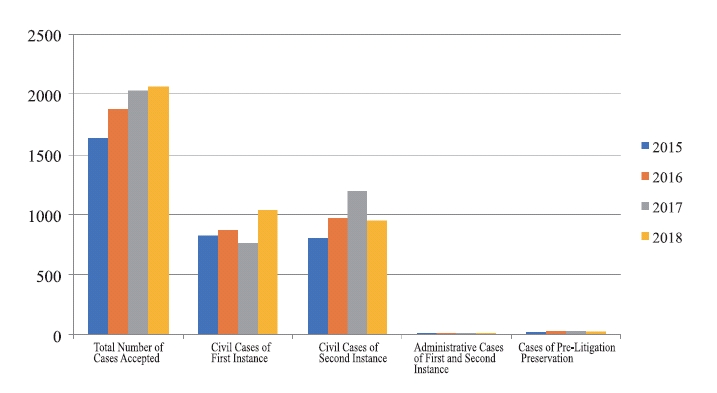
Figure 1 Comparison of Case Number Accepted
Among the cases accepted by SIPC, the top five categories in terms of number were copyright cases (excluding computer software copyright), 605 and accounting for 29.27%.; patent cases, 587 and accounting for 28.40%; computer software cases, 396 and accounting for 19.16%; trademark cases, 237 and accounting for 11.47%; cases of franchise contracts, 82 and accounting for 3.97%. In addition, there were 76 cases of unfair competition, 19 cases of technical contracts, 7 cases of monopoly and 58 other cases. (See figure 2)
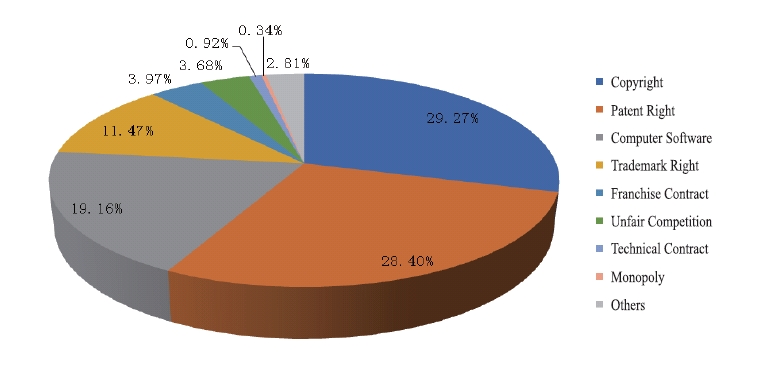
Figure 2 Distribution of Case Causes
Among the cases accepted in the first instance, 1,005 cases involved patent right, computer software, technical secrets and technical contracts, accounting for 96.73% of the total number of cases accepted in the first instance. Specifically, there were 546 cases of infringement on patent rights, 30 cases of ownership of patent rights, 11 cases of patent contracts, 318 cases of computer software development contracts, 78 cases of computer software ownership and infringement, and 22 cases of technical secrets. (See figure 3)
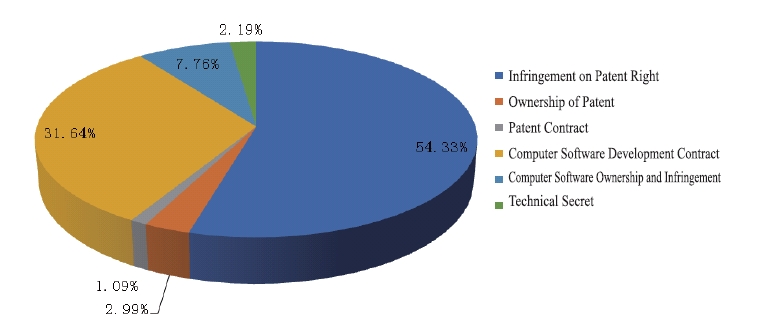
Figure 3 Distribution of Technical Cases
A total of 2,067 cases were concluded with an increase of 1.77 % on year-on- year basis. The case conclusion rate of the entire year was 100%, achieving a virtuous circle of case settlement. A slew of new types of cases were concluded. For instance, the case of dispute over monopoly between Wuhan Hanyang Bright Trade Co., Ltd. and Shanghai Hantai Tire Sales Co., Ltd. has been the first of its kind in China that the defendant was accused of both implementing vertical monopoly agreement and abusing its dominant role in the market; the case of dispute over unfair competition between Beijing Sogou Information Service Co., Ltd. and Beijing iQIYI technology Co., Ltd. involves whether the function of loading "search alternative option" in input method should be construed as unfair competition; the case of dispute over infringement on patent right for invention between Maddison Medical Co., Ltd. and Guilin Pharmaceutical Co., Ltd. involves the application of patent infringement exemption rules in Patent Law, such as "experiment exception" and "generic drug exception". In addition, SIPC concluded a number of cases involving well-known and highly influential Chinese and foreign enterprises and brands, such as the case of dispute over infringement on patent right of design filed by Volvo Rastwegener Company, the case of dispute over infringement on the trade mark between 85℃and Bright Dairy Co., Ltd. v. Gourmet Daren Co., Ltd., the case of dispute over infringement on unregistered well-known trademarks and unfair competition filed by Beijing Didi Infinite Science and Technology Development Co., Ltd., to name just a few. In the past year, a total of 26 cases won industry-wide acclaim. Some made it to the list of typical cases of the Communique of Supreme People 's Court, 10 Major Cases and 50 Typical Cases of Judicial Protection of Intellectual Property Rights of Chinese Courts, 10 Cases of Anti-Monopoly Civil Action of Chinese Courts from 2008 to 2018, 10 Typical Cases of Shanghai Courts, 10 Cases Concerning Judicial Protection of Intellectual Property Rights of Shanghai Courts, and Select Cases of Shanghai Courts while some others won the titles of model trial and excellent documents.
(II) Serving and Safeguarding the Implementation of the National Strategy and the Overall Situation of Shanghai’s Work
Focusing on the implementation of the national strategy and accelerating the building of "five centers" in Shanghai, particularly the building of science and technology innovation center, China (Shanghai) Pilot Free Trade Zone (hereinafter referred to as FTZ) and China International Import Expo (hereinafter referred to as CIIE), SIPC was committed to providing top-notch judicial services and effective judicial protection.
1. Serving and Safeguarding the Building of the Science and Technology Innovation Center
SIPC issued 25 guidelines on providing services to improve the business environment in an effort to create a law-based business environment facilitating science and technology innovation. Underpinned by the Research Base (Shanghai) of Judicial Protection of Science and Technology Innovation of Intellectual Property Rights established by the Supreme People’s Court, SIPC conducted in-depth research, compiled Research and Reference on Judicial Protection of Science and Technology Innovation, promptly reported to the Supreme People's Court on issues and practices related to the protection of intellectual property rights for science and technology innovation, and held a lecture entitled "Science and technology Innovation and Judicial Protection of Trade Secrets", playing the role as a think tank. The Office of National Trial Expert Chen Huizhen worked at full capacity, for example, conducting research and legal publicity in science and technology parks every month, holding themed lectures on the judicial protection of intellectual properties, going on circuit trials, and organizing attendance at trials, to just name a few. On top of that, it issued brochures of typical cases on intellectual property rights to acquaint enterprises with intellectual property laws and enhance the awareness and capability regarding intellectual property protection for innovative start-ups, especially for small and medium-sized micro-venture enterprises.
2. Providing Service to Guarantee the Building of FTZ
By giving full play to the intensified trial effect of intellectual property cases in FTZ, SIPC succeeded in handling intellectual property cases involving FTZ in a professional and efficient manner. A total of 310 cases were accepted and 291 were concluded. In addition, SIPC participated in forums regarding judicial protection of intellectual property rights in FTZ, joined hands with the IP court in FTZ of the People's Court of Pudong New Area, Shanghai Municipality, put more efforts in analysis and research on difficult issues arising out of the application of law to unify trial standards. SIPC also deepened cooperation with the management committee of FTZ, held enterprise forums, released Trial of Intellectual Property Rights Cases in FTZ (2015-2017), provided in-depth interpretation of the characteristics of dispute cases involving intellectual property rights in FTZ and put forward suggestions on specific protection measures. Moreover, SIPC handed out brochures of typical cases to business representatives, listening attentively to their opinions and advices, making the intellectual property protection in FTZ better-directed and effective.
3. Serving and Supporting CIIE
SIPC proposed 15 guidelines on serving and supporting CIIE, set up a panel of experts to deal with cases involving CIIE, and centralized the hearing of intellectual property cases involving CIIE. Working together with primary courts, SIPC established a liaison system for cases involving CIIE, and put great efforts in guiding trial and unify law application. Apart from that, SIPC established a special data analysis platform, actively participated in the research on intellectual property protection issues organized by Shanghai High People’s Court and China International Import Expo Bureau, carried out forward-looking research, analysis and prediction on cases involving CIIE and legal issues that might emerge during CIIE. In the lead up to CIIE, SIPC sorted out the basic information of intellectual property rights involving expos, analyzed common issues that might arise out of the protection of intellectual property rights, and put forward specific suggestions. All these efforts resulted in a report entitled Strengthening the Protection of Intellectual Property Rights Involving Expos and Driving Healthy Development of Expos, which was rated as one of the top ten research reports of people's courts in 2018.
(III). Strengthening Judicial Protection of Intellectual Property Rights
1. Fully Reflecting the Market Value of Intellectual Property Rights
Where the actual loss of a right holder can be ascertained to have exceeded the statutory maximum amount of compensation, the amount of compensation shall be determined according to the specific circumstances such as the value of the product involved in the case, the number of infringed products, the duration of the infringement and the failure of the tort-feasor to provide evidence of profits gained from the infringement. As for the case of dispute over computer copyright filed by Dasuo Systems Co., Ltd., SIPC, after considering all the evidences in accordance with the above rules on determining damages, the unit price listed in the sales contract submitted by the defendant, and the fact that the defendant used the software in larger scale even after being imposed with administrative penalties, ordered the defendant to pay RMB 9 million yuan as compensation, an amount far exceeding the statutory amount of compensation. SIPC also resorted to social organizations and intermediaries specializing in evaluating the values of intellectual property rights so as to determine the amounts of compensation based on the market values of intellectual property rights. Take for example the case of dispute over infringement on patent right for invention filed by Honda Technology Industry Co., Ltd., the profits gained by the defendant from infringement was determined according to the opinion of an accounting firm on the sales of products accused of infringement, and the defendant was ordered to pay RMB 2.4 million yuan as compensation.
2.Cracking down on Severe Infringements
For those cases involving source infringement, repeated infringement, malicious infringement or other serious circumstances, the degree of harmfulness and subjective maliciousness will also be taken into account, and the maximum compensation will apply according to the law, thus increasing the cost of infringement and effectively deter the infringements on intellectual property rights. SIPC will impose more vigorous punishment over the manufacturers of infringing products so as to prevent infringing from the source. In the case of dispute over infringement on trade secrets filed by Magnetic Control System (Shanghai) Co., Ltd, in light of the fact that the appellees, both the individual and the company, were the sources of tort, and evaded the legal responsibility out of subjective malice by making use of the independent legal personality of the company, SIPC upheld the first instance judgment that the infringer should compensate RMB 3 million yuan for economic losses. Another typical example is the case of dispute over infringement on trade mark and unfair competition filed by 3A Compound Co., Ltd. The loss of the right holder and the profits gained by the infringer were difficult to determine. In view of the fact that the trademark involved enjoys a high reputation, and the infringer counterfeited in an all-round manner out of subjective malice, SIPC decided to uphold the first instance judgment that the infringer should compensate RMB 2.5 million yuan for economic losses
3. Providing Support for the Right Holders’ Expenses on Protecting Their Legal rights
As for the cases whose infringement facts and reasonable expenses were certain, the claims by the right holders for compensation of reasonable expenses were supported in order to reduce the cost of safeguarding their rights and encourage the right holders to safeguard their rights. For example, in the case of dispute over infringement on patent right of invention filed by Canon Co., Ltd., given the fact that the plaintiff provided evidence for reasonable expenses such as notarization fees and attorney fees, and in consideration of the amount of work of the attorney accepted by the court, SIPC supported the claim of the plaintiff and ordered the defendant to pay compensation for the reasonable expenses at RMB 140,000 yuan in full amount. In the case of dispute over infringement on trade mark filed by Amore Pacific Co., Ltd., in view of the fact that the plaintiff paid a large amount of investigation fees, notarization fees and other reasonable expenses to prove that the trademark involved in the case was a well-known trademark, and provided corresponding evidences, and the fact that the trademark involved in the case was indeed a well-known trademark, SIPC fully supported the claim by the plaintiff for compensation of reasonable expenses at RMB 50,000 yuan .
4.Strengthening the Procedural Guarantee for Realization of Rights
SIPC brought to full play temporary litigation measures such as property preservation, evidence preservation and behavior preservation. In case the concerned parties applied for temporary litigation measures before or during litigation, SIPC actively accepted, promptly reviewed, ruled in accordance with the law and executed promptly, so as to lay a solid foundation for the effective trial of cases and the settlement of disputes. In 2018, there were 104 cases in which SIPC supported the applications by the concerned parties for litigation preservation. SIPC actively guided the concerned parties to take on the burden of proof. However, if the concerned parties were unable to collect evidence by themselves due to objective reasons, and if the requirements of the application for an order of investigation weremet, court investigation orders would be issued to their lawyers. In 2018, SIPC issued 36 investigation orders, effectively reducing the burden of proof on the right holders. If a party refused to submit or intentionally destroyed evidence or submitted fake evidence to interfere with the proceedings without justifiable reasons, SIPC would accept as true the facts claimed by the applicant according to the law, and impose punishments such as fines and detention on the interferer. During the hearing of the case of dispute over infringement on utility model patent filed by Dongguan Hongbang Precision Machinery Technology Co., Ltd., part of the sealed-up equipment placed at the defendant’s place was dismantled and moved due to the neglect of duty of the person in charge of the accused unit, resulting in damages to the seized evidence. Thus SIPC ruled that the person in charge of the accused unit shall be punished according to law.
(IV) Constructing a New Mechanism of Intellectual Property Protection
1. Deepening the Diverse Mediation Mechanism for Intellectual Property Disputes
SIPC further cooperated with mediation organizations and trade associations to build a professional mediation platform and a team of professional mediators conforming to standards & regulations. Entrusted mediations were utilized to the full before and during trials to efficiently resolve conflicts for the parties concerned. In 2018, 86 cases entered pre-trial mediation with the consent of both parties, and 34 cases were successfully settled with a success rate of 39.5%; 304 cases entered mediation during trial with the consent of both parties, and 123 cases were successfully settled with a success rate of 40.46%. In a case of dispute over infringement on patent right, due to the flexible adoption of pre-trial and during-trial mediation, the defendant and the plaintiff were reconciled with each other in court, and both parties sent thank-you letters to SIPC afterwards.
2. Introducing the Pre-judgment Mechanism
The pre-judgment mechanism was introduced to reduce the time-consuming trial process of intellectual property case. For those cases whose nature of infringement could be determined but other facts entailed further investigation, SIPC would make pre-judgment to stop the infringement first, thus improving the effectiveness of judicial relief. In the case of dispute over infringement on patent right of invention filed by Valeo Systemes D’Essuyage, the plaintiff held that the infringement would continue in the process of trial, affecting the business of the plaintiff, and thus requested SIPC to make pre-judgment that the defendant should stop the infringement immediately. The collegial panel asked the parties concerned to provide, cross-examine and debate the technical facts of the case, and the expert jurors and the technical investigation officers jointly inspected the infringing products. It was finally determined that the product sued for infringement fell into the patent protection scope enjoyed by the plaintiff. Accordingly, SIPC made a pre-judgment of first instance and ordered the defendant to immediately stop the infringement on the patent right of the invention involved.
3.Improving the Multiple Mechanism for Ascertaining Technical Facts
In response to the advanced technologies and expertise involved in intellectual property cases, more efforts were put into the implementation of the "four in one" technical fact investigation and confirmation system, namely technical investigation, technical consultation, expert jury and technical appraisal. Appropriate ways to investigate technical facts would be chosen according to the actual circumstances of a case. Priority was given to the mechanisms of technical investigation, technical consultation and expert jury, and a system of 45-day notice, 60-day notice after and feedback for appraisal was established to improve the efficiency and effectiveness of judicial appraisal. For those cases concerning intellectual property rights involving multiple disciplines and fields, a collaborative mechanism of technical investigators, technical consulting experts, expert jurors and appraisers had been actively explored. In the case of dispute over infringement on patent right of invention filed by Beijing Sogou Science and Technology Development Co., Ltd., the technical investigation officers and technical experts of appraisal institutions participated in the investigation, while expert assistants and appraisers appeared in court to cross-examine the case, jointly helping to find out about the technical facts of the case. In 2018, technical investigators participated in 131 technical investigation cases, up 84.5% from the previous year. Last year also saw 412 times of technical consultations, technical preservations, investigations and court appearances, a year-on-year increase of 36.4 %, achieving good results.
4.Expanding the Mechanism of Smart Supporting Technologies
SIPC had been actively promoting synchronous generation and in-depth application of electronic dossiers, constantly expanding its functions, and integrating modern technology with judicial work, pushing forward the application of modern technology to judicial work. SIPC adopted online case handling during the whole process of trial, among others: digital collection of litigation materials, circulating electronic dossier between the upper and lower courts, realizing paperless trial evidence presentation in the process of trial evidence presentation and cross-examination which enabled the collegial panels to review electronic dossier materials, add online notes and make appraisals online, and make judgment documents online. SIPC adopted the intelligent voice transfer system in court trial, and attempted to use audio and video recording to replace the traditional way of clerk recording. SIPC also participated in the "206" project initiated by Shanghai High People's Court and the construction of big data analysis database of patent cases.
(V) Creating a Sound Environment for Intellectual Property Protection
1. Stepping up Efforts in Promoting Intellectual Property Rights Protection
With stress laid on the theme of publicity, the features and highlights of intellectual property rights protection were fully manifested. For instance, in-depth reports on the operation of technical investigator system were published on state media such as People's Daily and Xinhua News Agency; articles regarding how to effectively solve the "three major difficulties" of intellectual property protection were published in series on Liberation Daily; comprehensive reports such as China Attaches Importance to Intellectual Property Rights and Enhances Innovation Capacity were published in the overseas edition of Xinhua News, the overseas edition of People's Daily and China Daily. Trials of foreign-related cases were covered on Legal Daily and other professional law media; the basic information of SIPC’s judicial protection of intellectual property rights was covered in an all-round way on Chinese Intellectual Property Right News, Power of Intellectual Property and other IP media. Moreover, SIPC made innovations in terms of the forms of publicity and combined traditional and new media to launch a publicity campaign. For instance, on the World Intellectual Property Day of 2018, a public service program of intellectual property was broadcast on Morning News of Shanghai People's Broadcasting Station; the presiding judge of SIPC was invited as a special guest to a live interview TV program called "Looking at the World with Legal Eyes -the Chief Judge is Now Online" during which he exchanged ideas with the host, audience and netizens about the protection of intellectual property rights; SIPC compiled and distributed 3 collections of cases concerning judicial protection in business environment and collections of common cases of intellectual property rights, set up a column named "Case Study" on the official website of SIPC, organized 10 times of public open days, and assigned judges to participate in public lectures on copyright protection in China.
2.Continuously Increasing the Influence of Intellectual Property Trial
Efforts were stepped up when it came to judicial research on intellectual property rights, realizing outstanding achievements. A total of 46 papers and case reviews were published in journals such as Application of Law, People's Judicature and Shanghai Trial Practice; five papers and case analysis including Functional Positioning and Institutional Coordination of Technical Investigators in Intellectual Property Trial won awards in competitions such as the 2018 Essay Competition held by the Trial Theory Research Institute of China Law Society, and 2018 Excellent Case Competition of the National Court System, etc.; 9 research subjects were completed, among which Reform and Innovation in the Field of Intellectual Property Trial -- from the Perspective of Establishing Rules for Litigation Evidence in Line With the Characteristics of Intellectual Property Cases was awarded as an outstanding key research subject by Shanghai High People’s Court in 2018. In addition, SIPC actively participated in international exchange programs, making China’s voice for judicial protection of intellectual property rights heard globally. 12 groups of overseas experts and peers from the EU Intellectual Property Bureau, the International Trademark Association, Japan, the Republic of Korea and ABU Dhabi, United Arab Emirates were received by SIPC. It also sent delegates to the Forum on International Trade Rules and Intellectual Property, the 15th Shanghai International Forum on Intellectual Property and the Global Conference on Intellectual Property Protection and Innovation, and the Seminar on Intellectual Property Protection and Competition in the Era of Technology Revolution. Four judges were invited to exchange programs abroad and several judges were invited to teach in WIPO-Tongji University Intellectual Property Master's Degree Program. SIPC was highly praised by organizations and enterprises both at home and abroad for fairness and high efficiency of trial. For instance, Beijing Didi Infinite Science and Technology Development Co., Ltd. thanked SIPC for its unremitting efforts to protect the legitimate rights and interests of enterprises and maintain a fair competition in the market; SAP Co., Ltd., Orekang Textile Co., Ltd. and Volvo Rastwegener Company, etc. appreciated SIPC for showing equal respect for the intellectual property rights of multinational companies and for protecting their intellectual property rights, and according to them, SIPC "builds a highly efficient judicial environment in China and becomes a model worldwide."
3. Continuously Improving the Satisfaction Degree of Intellectual Property Lawsuits
Trials of cases involving intellectual property rights had been much more convenient than before. Pre-trial meetings, online mediation and online trial of intellectual property cases were applied to trial of intellectual property cases, and a total of 187 cases were held via online remote video in the whole year. In a case of dispute on computer software development contract, the witnesses who could not make it to the court were asked to complete the process of witness testimony and cross-examination with the parties via remote video. More efforts were made to build litigation service centers, the 12368 litigation service platform and online lawyers service platforms, so as to make the litigants and lawyers more satisfied with litigation services. Apart from enabling lawyers to review dossiers online, special efforts were put into popularizing online filing, with a total of 190 cases registered online. The entrusted notarization service mechanism worked effectively. Through the "notarization cloud" data storage platform, the whole process of delivery was able to be tracked down, not only improving the success rate of delivery, but also realizing notarization preservation in case of failed deliveries. 64 pieces were successfully delivered in this way. The trial of intellectual property cases were more transparent. SIPC made more efforts to broadcast trials live on an average of 2 cases per week on China's Court Trial Live Broadcast Network, and made public all the effective judgments that should be made public according to the law, so as to effectively guarantee the people's right to know, to participate, to express and to supervise. SIPC also subjected itself to the supervision of the public. A total of nearly 40 people in 3 batches, including members of the National People's Congress, the Shanghai Municipal People's Congress and CPPCC, visited SIPC to conduct investigation and inspection, and they gave due recognition to the work of SIPC.
In 2018, the first intellectual property tribunal of SIPC was honored as an advanced collective of national intellectual property trial, and the Party Branch of the first intellectual property tribunal was rated among one of the advanced Party branches of the municipal organizations. The second intellectual property tribunal won First-class Merit of Shanghai Courts. Judge He Yuan was awarded as Advanced Individual of National Intellectual Property Trial as well as Model Judge of National Courts. 10 judges and assistant judges were awarded third-class merits and won the honorary titles of Good Judge, Good Cadre, Model Judge of Shanghai Courts and Advanced Individual like Zou Bihua, and many more.
In 2019, we will, under the guidance of Xi Jinping's ideology of socialism with Chinese characteristics in the new era and in accordance with the arrangements of the Shanghai Municipal Party Committee of the CPC, the Supreme People's Court and Shanghai High People’s Court, ramp up our efforts in judicial protection and deepen judicial reform. We will make bigger strides towards the goal of building a world-class intellectual property court so as to provide excellent service and solid guarantee for the implementation of the national strategy and drive the economic and social development of Shanghai.